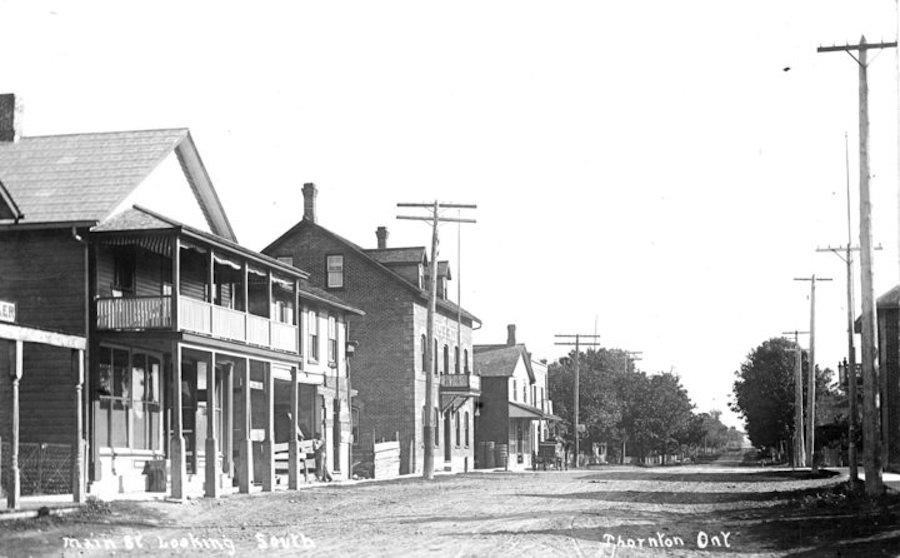The men of Thornton took up their positions on the rooftops and upper floors of the main street and pointed their long guns at the target below. In a scene seemingly ripped from a John Wayne film, they fired at will while the women and children of the village made themselves scarce.
The cause of this wild west scene in 1912 was one stray dog. That particular year had seen a significant outbreak of rabies in the province and local folks were taking no chances when it came to potentially infected animals.
The event unfolded in February of 1912 when an unfamiliar canine wandered into their midst displaying signs of the madness that accompanies the later stages of hydrophobia. It challenged and bit several dogs, and attempted to attack more than one Thornton resident. A young girl sweeping a doorstep had a narrow escape when the creature lunged at her but her quick action – with the broom as her weapon – allowed her to quickly duck indoors.
Joseph Sproule wasn’t so fortunate. Mr. Sproule was outdoors and completely unaware of the looming threat when the dog came out of nowhere and sunk its teeth into the man’s hand. In short order, the entire community was made aware of the dangerous situation and everyone took action, whether it be going into hiding or arming themselves to deal with the intruder.
The Northern Advance reported that, “After the dog had careened around the village for an hour or more and been fired at several times it was finally put out of business by a shot from an upstairs window.”
In the aftermath, all of the dogs of Thornton were either shot as well or confined until their status of health could be determined.
In these early days, dogs almost always ran free, and livestock and wildlife often mixed. Only a few decades earlier, the Town of Barrie had passed a bylaw instructing their citizens to confine their cows to their own property whereas previously they been allowed to roam through the entire community, grazing in flower gardens and making a mess in the downtown business district.
Joseph Sproule was quickly attended to by a doctor who strongly advised that he be sent immediately to Toronto for treatment and that the head of the animal be sent to a provincial laboratory for analysis. The lab results that followed in a few days confirmed that the dog had been in the advanced stages of rabies.
Sproule was lucky that he lived in a time and a place where he could have a hope of surviving the dreaded hydrophobia. It wasn’t until 1885 that Louis Pasteur developed the nerve tissue vaccine that has evolved into the treatment used today. Toronto General Hospital, by 1910, had partnered with the Pasteur Institute of New York and had begun importing vaccine for Canadian cases.
Mr. Sproule spent two weeks in Toronto and came back a cured man. However, he only lived another three years and it’s unclear if his brush with the rabid dog shortened his life. Sproule was 70 years of age at his passing and his cause of death was listed as spastic paraplegia, a progressive disease of the brain, nerves and spinal chord with symptoms that sound eerily similar to those of the rabies disease.
Before the common use of modern rabies vaccines, the threat of the relentless, horrible and always fatal disease terrified all. Of course, no one understood how it was spread or how to cure it which gave rise to the usual quackery and junk remedies concocted to sell to desperate people.
“There is a very simple method for curing hydrophobia and that form of epilepsy that is often mistaken for it, which is known as the Buison treatment, which is effected by forcing the poison through the pores of the skin by profuse perspiration.”
The short article in the Jan. 6, 1898 edition of the Northern Advance went on to say that if convulsions had already taken place “the patient should enter a vapour bath of 140 degrees Fahrenheit and remain there until all symptoms of hydrophobia have disappeared” and this should be done for seven consecutive days.
The writer added that if no Turkish baths were to be found nearby, one could simply gain the same results by excluding as much air as possible from a room where a patient wrapped in blankets would be placed on a chair over a pot of boiling water on a lighted oil stove.
I am forever grateful for the advances in modern medicine!
Each week, the Barrie Historical Archive provides BarrieToday readers with a glimpse of the city’s past. This unique column features photos and stories from years gone by and is sure to appeal to the historian in each of us.



